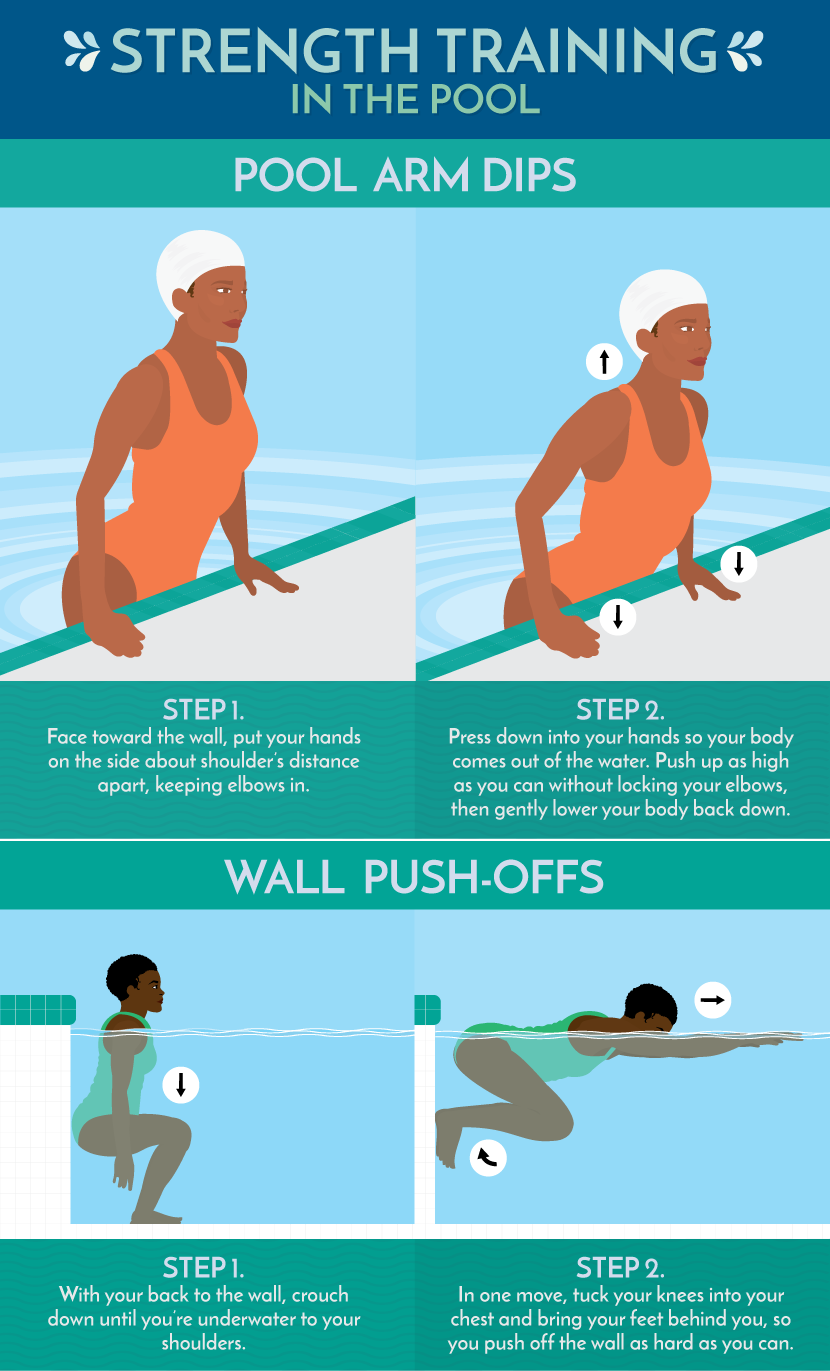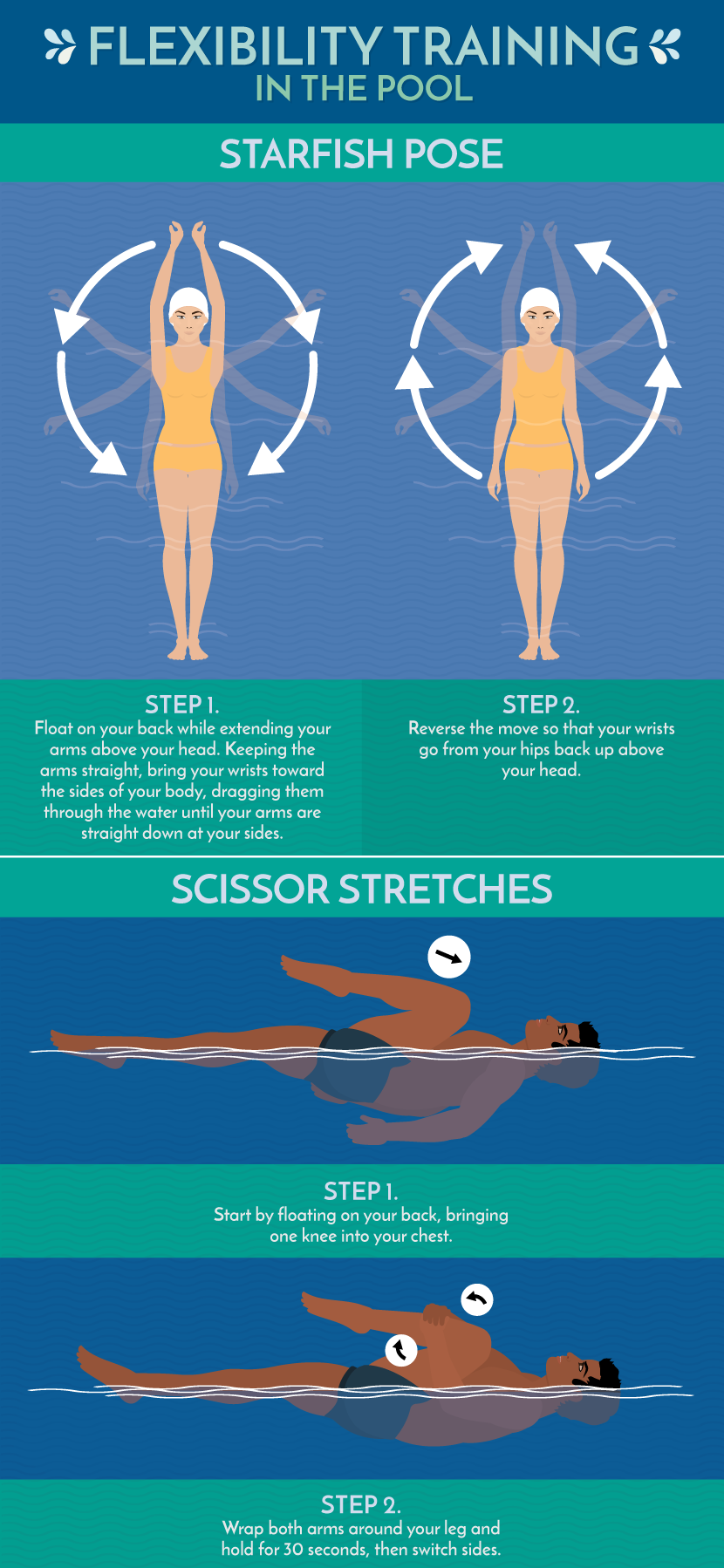Make a Splash: The Health Benefits of Water Workouts!
The pool is an amazing place to get fit – and believe me, if you build the right workout, you’ll find yourself sweaty and sore
after just a short amount of time! From using weights to some specific swimming drills, build strength and endurance the next time you’re in the water.
As a personal trainer, I can tell you that moving your workout to the water can be a great way to work up a sweat, build muscles, increase your cardiovascular fitness, and much more.
Before you go jumping right in, there are a few safety pointers to keep in mind:
- Even strong swimmers can get a cramp, find themselves in deeper water than they can handle, or just need a break.
So never, ever work out in the water alone. Grab a buddy or, better yet, buddies, so you can always have at least one
person out of the water to keep an eye on things
- If you’re in the pool, stay close to the side. Not only is it there for you if
you need a rest, it’s a great place to do many of the exercises themselves!
- If you’re outside, watch out for the elements! Slather yourself in sunscreen so you don’t get
burned, take a look around to make sure you won’t be near any boats or other people, and make sure
that you find safe footing in a sandy spot
- Stay hydrated. Just because you’re in the water doesn’t mean the water is in you!
And you may not feel yourself sweat, so be sure to stay on top of your hydration and
take breaks if you need them
And as always, never start a fitness regime of any kind without your medical provider’s approval.
Let’s break the workout options down into cardio, strength training, and flexibility. You can focus on one or mix up your
routine to include all three! Just make sure you warm up and cool down at the beginning and end of the workout.
Warmup
Before you get in the water, make certain that your muscles are warmed up and you’ve started to
get that heart rate going. Try marching in place for a few minutes, maybe even raising and lowering
your arms to increase the intensity. A few static stretches may also feel good, so gently take one
arm across your body and hold it there for 30 seconds before switching sides. Do the same to loosen
up your legs: bend your right foot behind you and grab it with your right arm, bringing it as close
to your glutes as possible. Hold for 30 seconds and switch sides.
Cardio
Ready to Go?
Start with a few laps! If you’re a strong swimmer, I recommend that you do a short individual medley (IM). Try one lap
each of butterfly, backstroke, breaststroke, and freestyle. Your form matters, of course, but you’re not in the Olympic trials,
so just work on doing the lap as fast as you can.
- Need more intensity? Try two laps of each stroke, and then go for several (3-5) sets. Add flip turns if you know how,
or alternate sets with arms only (dragging your legs behind) and legs only (using a kickboard or putting your arms out in
front for balance)
- Too intense? The breaststroke is something almost everyone can do, because you don’t have to put your face
fully in the water. But it still gets your heart rate going, so do as many laps as you can until you start to feel
like you’re getting a good workout

Jog in place: Find a spot where your feet can touch but you’re underwater up to your waist or stomach. Start slowly,
then pick up the pace. How high can you get your knees? Try doing this for 60-second intervals: one minute on, one minute off.
Need more intensity? Try jogging while holding both arms in the air, or even holding a light waterproof weight or block.
Squat jumps: Find a spot where your feet can touch but you’re underwater up to your waist or stomach. With your feet about
hips-width apart, bend your knees until the water’s up to your neck, then push off and jump as high as you can.
- Need more intensity? Go all the way underwater and clap your hands above your head as you jump up
Pool wall kicks*: Starting with your face toward the wall, put both hands on the side and gently push yourself
back until your body is floating, close to parallel with the ground. Flutter your legs up and down and start to pick
up the pace until it feels like the right intensity. Try doing this for 30-second intervals.
- Need more intensity? Put your face in the water and breathe from side to side, rather than keeping your face out of the water
- Ready to change it up? Flip over so you’re on your back, with your arms resting on the pool wall, perpendicular to your body (in a T shape).
Engaging your core muscles, flutter your legs up and down for 30-second intervals
In an ocean or other body of water? You can use a kickboard or noodle instead of the wall, or put your arms in front of you.
Strength
Let’s build some muscle!
Pool arm dips*: Starting with your face toward the wall, put your hands on the side about shoulder-distance apart. Keeping your elbows in so they’re brushing the side of your body, press down into your hands so your body comes out of the water. Push up as high as you can without locking your elbows, then gently lower your body back down. Try 10 repetitions, and then try to complete three full sets.
- Ready to change it up? Sit on the side of the pool with your fingers pointed behind you (and your wrists facing forward).
Gently lower your body into the water, but hold your body up so that your elbows and shoulders are at a 90-degree angle.
Engaging your triceps, gently press down into your hands, straightening your arms, then lower again. These tricep dips can
be pretty intense, so start with five repetitions and three full sets.
In an ocean or other body of water? You can do these on the ground or sandy area, switching the front-facing dips for push-ups
and doing the tricep dips with your legs outstretched and heels on the ground.
Wall push-offs: With your back to the wall, crouch down until you’re underwater to your shoulders. In one move, tuck your knees into your chest and bring your feet behind you, so you push off the wall as hard as you can. This is an explosive move, so the harder you push and the closer you start to the wall, the more you’ll engage your quads!
- You can vary the intensity of this by keeping your head above the water or pushing off
underwater and seeing how long you can swim without coming up for a breath.
In an ocean or other body of water? Try dolphin dives instead! Crouching down into a squat position,
push off the ground as hard as you can, but instead of coming back down to the starting position, do a miniature
dive, leading with your arms and head and coming down a foot or two in front of where you started.
If you have waterproof weights, add these in! You can do underwater tricep push-downs and kick-backs, underwater bicep curls, and much more.

Flexibility
It’s time to embrace your inner synchronized swimmer!
Synchronized starfish: Start by floating on your back, then extend your arms up so your body creates a long line. Keeping the arms straight, bring your wrists toward the sides of your body, dragging them through the water until your arms are straight down at your sides. Reverse the move so that your wrists go from your hips back up above your head.
- You may need to keep a kickboard or float between your legs for balance!
- Time to add on! At the same time as you bring your arms down, take your straight legs out to the sides, separating the
ankles and stretching as far as you can go. At the end of the move, your arms will be at your sides and your legs will form
an inverted V. Switch, so that your arms go back up and your legs come together.
Scissor stretches. Start by floating on your back, then bring one knee into your chest, wrapping both arms around it. Hold it there for
30 seconds, then switch sides. You’ll need to engage your core muscles to stay floating, and the more you pull the knee in, the deeper the stretch will be.

Cooldown
That’s the workout! And don’t be fooled – it may look like water dripping off your face, but a lot of it is sweat, so take five to ten minutes
and really take it easy before leaving the water. I like to do a few laps of sidestroke or breaststroke, with my face out of the water. You can
also float on your back, keeping still and bringing your breath back to normal. And remember, when you get out, a few static stretches can help
ease the delayed onset muscle soreness you may feel a day or two after the workout.
Embed the article on your site

